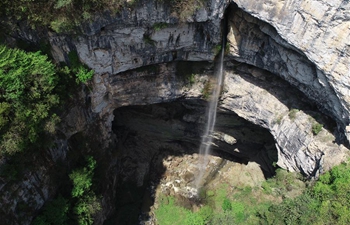LOS ANGELES, April 23 (Xinhua) -- NASA's Mars InSight lander has measured and recorded for the first time ever a likely "marsquake," said a release of NASA on Tuesday.
The faint seismic signal, detected by the lander's Seismic Experiment for Interior Structure (SEIS) instrument, was recorded on April 6, the lander's 128th Martian day.
This is the first recorded trembling that appears to have come from inside the planet, as opposed to being caused by forces above the surface, such as wind, according to NASA.
Scientists still are examining the data to determine the exact cause of the signal.
A video and audio clip was posted on the NASA website, illustrating the seismic event recorded by InSight's SEIS. The instrument measured three distinct events, namely, Martian wind, marsquake and the spacecraft's robotic arm as it moves to take pictures.
The audio was produced from two sets of sensors on the SEIS. According to the mission team, audio from both sets of sensors has been sped up by a factor of 60. The actual vibrations on Mars would not have been audible to the human ear.
"We've been collecting background noise up until now, but this first event officially kicks off a new field: Martian seismology," said InSight Principal Investigator Bruce Banerdt of NASA's Jet Propulsion Laboratory in Pasadena, California.
The new seismic event was too small to provide solid data on the Martian interior, which is one of InSight's main objectives, according to the mission team.
The Martian surface is extremely quiet, allowing SEIS to pick up faint rumbles. In contrast, Earth's surface is quivering constantly from seismic noise created by oceans and weather, according to NASA.
The SEIS, which InSight placed on the planet's surface on Dec. 19 last year, will enable scientists to gather similar data about Mars. By studying the deep interior of Mars, they hope to learn how other rocky worlds, including Earth and the Moon, formed.


















